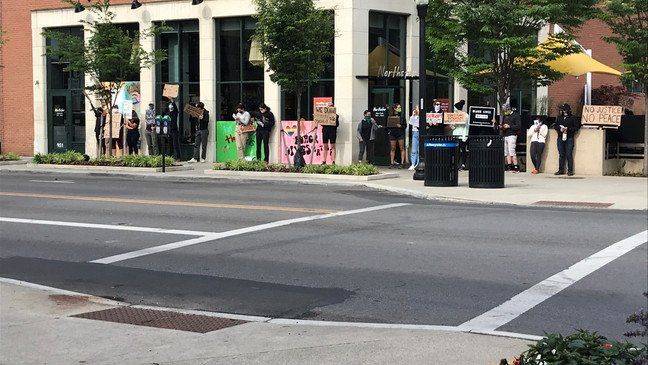13 Reasons why it’s okay to celebrate (and question) Beyonce this week
1. Afros and more afros. In 2016, Black women are still being chastised at work for wearing our hair the way it grows out of our head. While U.S. corporate culture makes it mandatory for Black women to straighten our hair , one of the most popular singers in the world decided to celebrate it in its natural state. That’s cool with me.
2. Loving the Black aesthetic. She likes her man’s big nostrils. Jackson 5 nostrils to be exact. Celebrating the pre-nose job Jackson family faces seems like a nod to Afrocentric phenotypes. I’ll take it.
3. Berets and Black women in the Black Panther Party.
This year is the Black Panthers 50th anniversary. I didn’t realize that until someone told me, so now I feel like a bad scholar and my academic Black card might be on the brink of being revoked… Nonetheless, it took Beyonce to bring it to our (or at least some of our) attention. What makes the image of a large group of Black women in the Black Panther Party’s iconic hats so interesting is that the Party was formed in a time of not only extreme racism, but of oppressive patriarchy. Towards the end of the 1960s Black women entered the Party in droves, but not all were well received. Many Black men saw themselves as taking a new role in leading their homes and communities at the expense of silencing the women in their lives. But Beyonce and her crew made sure we saw them during the country’s most watched program of the year. Black-gloved fists and all. I’ll take it. Shout out to the rank-and-file sistas in the movement. Which brings me to my next point…
But Beyonce and her crew made sure we saw them during the country’s most watched program of the year. Black-gloved fists and all. I’ll take it. Shout out to the rank-and-file sistas in the movement. Which brings me to my next point…
4. Berets and booty shaking. If you’re one of those folks who had a problem with Beyonce referencing the Black Power Movement in a leotard then maybe you should consider what it means to police women’s bodies. It’s important to recognize how Eurocentric norms of femininity and the presentation of women’s bodies cloud our judgement. The Civil Rights Movement of the 1950s and 60s were very conscious of these norms as they marched in their Sunday best. But the Black Power Movement sought to overturn those norms. Might Beyonce’s Superbowl performance be another reiteration of overturning norms? What might it look like for pop culture and social movements to come together post- James Brown and Marvin Gaye ? Maybe it looks like “Formation.” Maybe.
5. Formation is the new Black power anthem? Ehhh… I love Beyonce believe me I do, but let’s pump the brakes a little. She’s definitely highlighting social movements, forms of Black New Orleans culture [Black Native American culture (2:34) Jazz funerals (2:54), Mardi Gras/ Playing Mas (3:18-3:23), Southern car culture (4:00), Southern Baptist traditions 4:07)], and specific challenges against the Black aesthetics that have affected her directly (ie. people commenting on Blue Ivy’s afro and her husband’s big nose.) But in the grand scheme of political pop culture it’s no Gil Scott Heron or Billie Holiday. But it is a step in that direction for the Millennials. Which brings me to #6…
6. I don’t require much depth from Beyonce. Kara Walker? Yes. Melissa Harris-Perry? Of course. Toni Morrison? All day. Oprah? Yes, mostly on Super Soul Sundays. Beyonce? Not so much. Because of this, I was excited to hear portions of Chimamanda Ngozi Adichie’s TEDx talk in Beyonce’s “Flawless.” And I am equally excited about Beyonce’s “Rhythm Nation-like” outfit mixed with a little Kathleen Cleaver in there. In the words of Janet “It’s time to give a damn let’s work together.” Get in Formation ladies. #BlackGirlMagic
7. People of color know about seasoning stuff. Hot sauce swag. Southern cooking and Black culinary skills “bey-bae!”
8. Symbolism… Let’s reflect. Beyonce in all Black with brief glimpses of a jazz funeral. What is being mourned? What life is being celebrated? A New Orleans police car submerged in the water of what looks to be a post-katrina neighborhood while empty homes remain afloat. Black women in a hair store stroking a straight-haired wig. Police officers in line dressed in riot gear watch as a little Black boy in a hoodie dances in front of them unafraid. The police put their hands up. What are they surrendering to? I don’t have any answers, just more questions.
9. Sexuality gets center stage. Beyonce uses scenes (apparently without permission) from the documentary The B.E.A.T. which is a celebration of New Orleans’ Bounce music – a subculture of hip hop. Specifically, she uses scenes showcasing male homosexual Bounce dancers and artists. These scenes plus the commentator discussing his love for collard greens and cornbread while announcing that he plans to unapologetically surpass expectations by ostentatiously impressing his competition, aka #slay, might make one think of James Wright Chanel . However such presentations of queerness is often placed in superficial frames of entertainment and humor. Beyonce continues to highlight the #BlackLivesMatter movement throughout the song (the boy and the cops, the “stop shooting us” graffiti, etc). But knowing the movement began as a way to address violence and discrimination towards the Black LGBT community, I’m left wishing that connection would have been made. Maybe that’s asking for too much in a 5 minute song (shrug).
10. A rich woman awarding men’s sexual favors with a basic restaurant. Turning the machismo tables by scoffing at the assumed power within male virility by rewarding him with Cheddar biscuits is kind of hilarious. However, on one hand, the gesture symbolizes her in control of her sexual decisions and places her in the power role as the decision maker and the one with access and resources (ie. ride in her helicopter and put you on the radio). On the other hand, is it productive for women to “play patriarchy” with money, sex and consumerism as the all too familiar back drops? Role reversal doesn’t change this exploitative social practice. But again it’s Beyonce’s so… see #6.
11. Setting the record straight. I’m convinced that the Illuminati accusers are the same folks who believe aliens built the pyramids. Really, people believe this. One might say Jay-Z took it too far calling himself “hovah” but I’m not convinced they are devil worshipers. But some spiritual power kept Beyonce from taking an “L” at the Superbowl.
12. Don’t forget Hurricane Katrina.
Don’t forget Hurricane Katrina.
Don’t forget Hurricane Katrina.
That is all.
13. Oh and just to be clear, Creole and Negro are both all Black. But I appreciate you, Beyonce, for holding onto that Louisiana subculture. For those unclear, it’s like saying mixing Appalachian and white to get Missouri-Kentucky or something. We get you Bey. The difference we can consider, however, is the implied class differences between “Negro” and “Creole.” Beyonce uses various accoutrements of an elevated class status of Creole women from centuries past: The home, Black portraiture, books, and decorative umbrellas. A confluence of race and culture with maybe a sprinkle of classism in there… maybe… but we get you Bey and see what you did there.




I don’t know the best way for pop culture and social justice efforts to join forces, but I’ll take this one. Artists will do what artists do and keep workin’ at it. Let’s not be afraid to celebrate, critique, and consider new approaches that take us out of our comfort zones. In the meantime, figure out how to affect your sphere of influence, twirl on your haters and don’t be afraid to do it with hot sauce in your bag… #swag



















